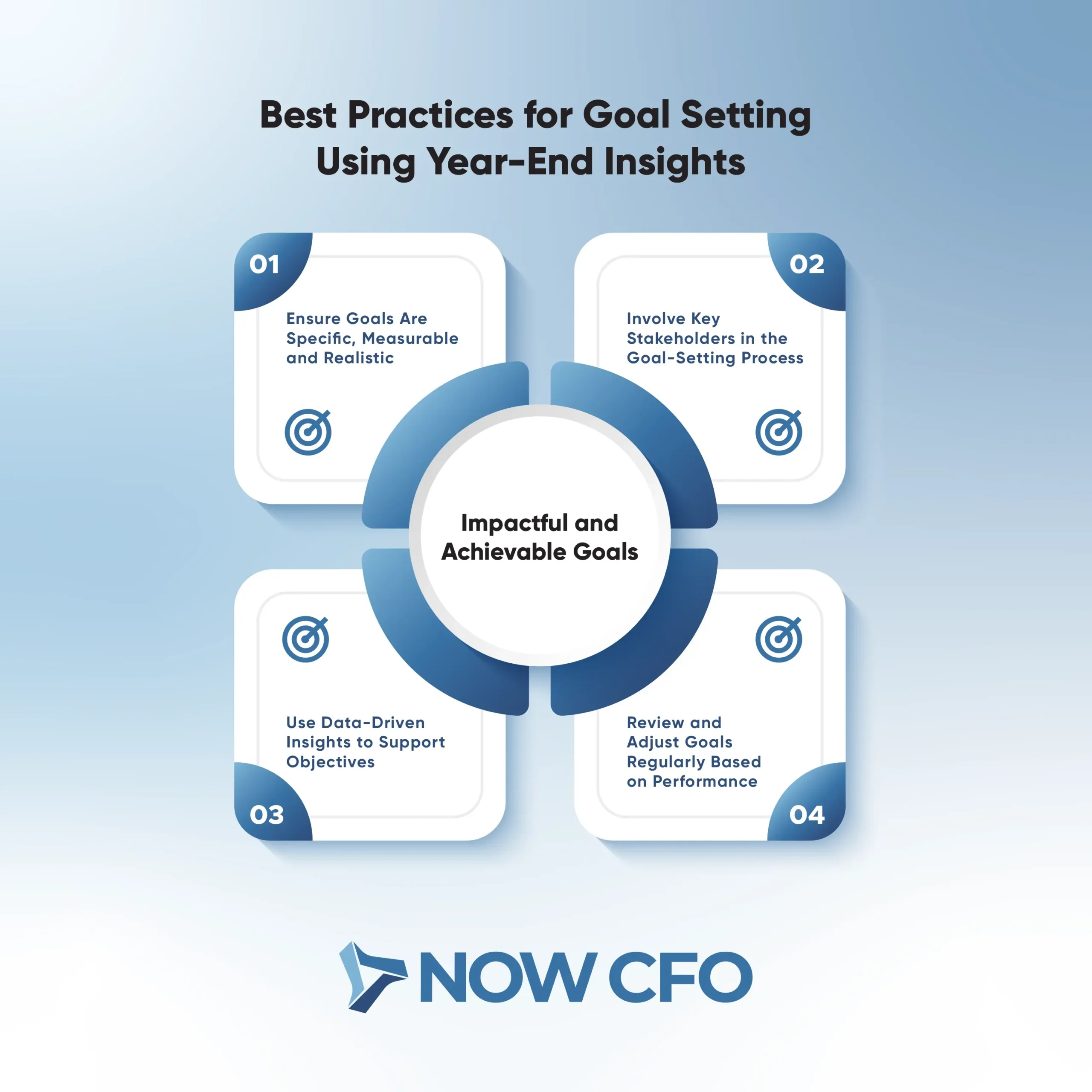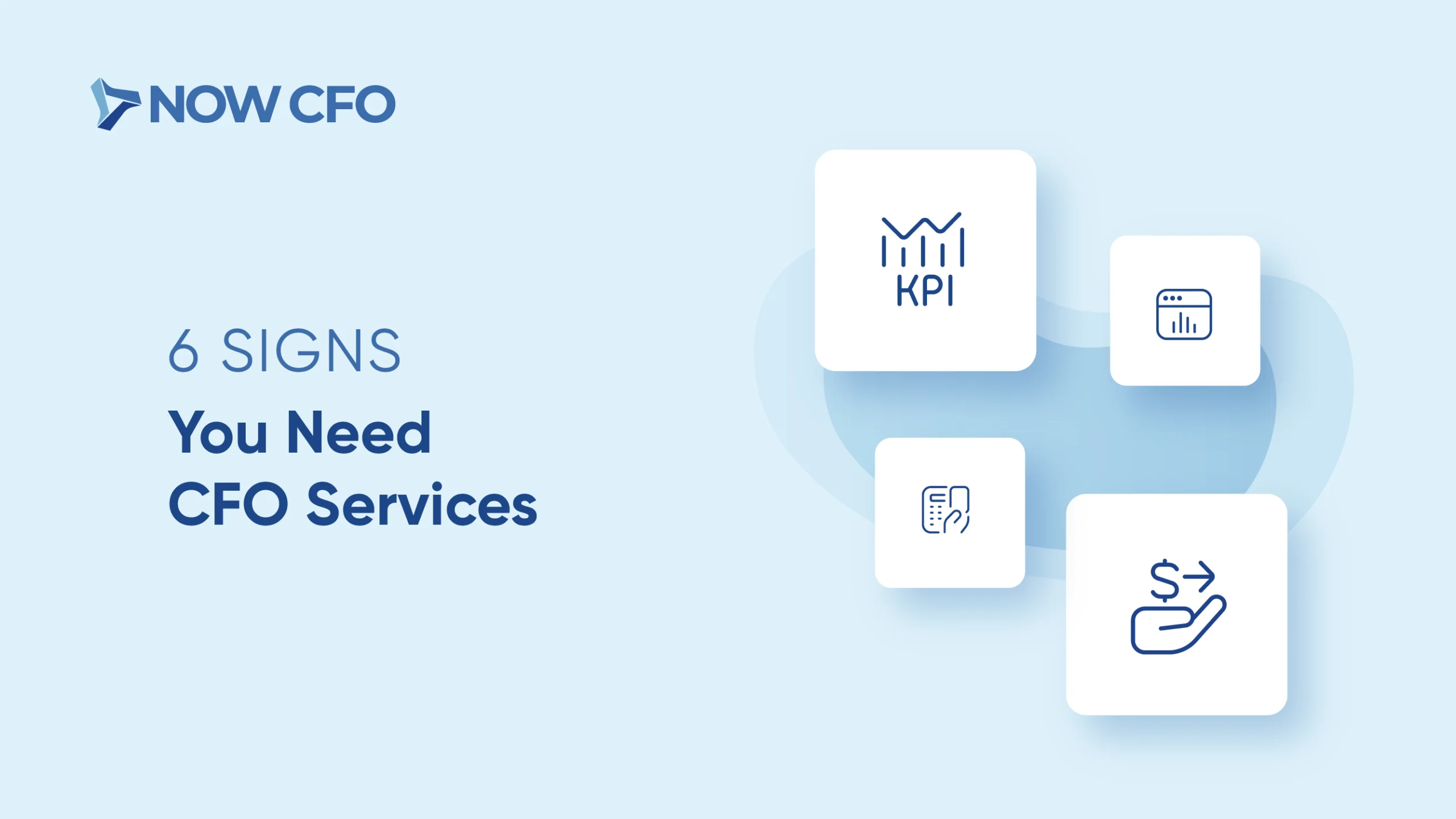
As the new year begins, setting financial goals becomes a top priority for businesses aiming for sustainable growth. Twenty percent of small businesses fail within the first year, and 50 percent fail within five years, often due to lacking strategic financial planning.
Year-end financial data analysis is an effective way to establish meaningful objectives. Whether focusing on revenue growth, cost efficiency, or improved cash flow, data-driven methods ensure goals align with long-term strategies and the market.
Why Year-End Data is Essential for Setting Financial Goals
Transitioning into a new financial year requires a comprehensive understanding of the previous year’s performance. Companies with clear economic goals are 42% more likely to achieve them.
Also, year-end financial data analysis lays the groundwork for setting informed, impactful financial goal setting for business.
Providing a Baseline for Performance Evaluation
Year-end financial data analysis is a benchmark for assessing your business’s progress. You can determine how well your strategies worked by comparing actual performance with projections. Key questions to consider include:
- Did revenue meet or exceed targets?
- Were operating costs managed effectively?
For example, if a company projected 15% growth but achieved only 10%, analyzing the shortfall can highlight underlying challenges, such as pricing strategies or market shifts. This baseline is crucial for defining actionable goals for the new year.
Identifying Key Financial Strengths and Weaknesses
Year-end and mid-year financial review highlights what’s working and what isn’t. For instance:
- Strengths: A product line that consistently generates high margins.
- Weaknesses: A department with rising operational costs that outpace its revenue contribution.
Understanding these aspects allows businesses to capitalize on their strengths while proactively addressing weaknesses. A focused approach improves efficiency and drives profitability.
Highlighting Trends to Inform Future Decisions
Patterns in year-end data provide valuable insights for decision-making. Examples include:
- Seasonality Trends: Recognizing peak sales periods to optimize inventory and marketing.
- Expense Patterns: Identifying rising costs that require immediate intervention.
For instance, a steady increase in customer acquisition costs could indicate the need to refine targeting strategies. Leveraging these trends ensures decisions are based on facts, not assumptions.
Supporting Data-Driven Strategic Financial Planning
Year-end data provides the foundation for data-driven planning. Instead of setting arbitrary goals, businesses can align them with actual performance metrics. For example:
- Use sales growth data to set realistic quarterly revenue targets.
- Analyze cash flow trends to prioritize liquidity goals.
This approach ensures goals are actionable, measurable, and achievable, fostering financial stability and growth.
Enhancing Financial Transparency and Accountability
Analyzing and sharing financial data increases transparency across teams. When employees understand how their roles impact financial performance, accountability improves. Transparent reporting also strengthens trust with stakeholders, such as investors or board members.
Steps for Analyzing Year-End Financial Data
Furthermore, the new year starts with understanding the financial landscape of the past year. Year-end financial data analysis is a retrospective and strategic step toward informed decision-making.
Review Income and Expense Trends
One of the first steps is to evaluate income and expense trends. Reviewing income statements can reveal whether revenue has grown steadily or if there are seasonal spikes. In 2022, average annual expenditures per consumer unit in the U.S. increased by 9.0% from the previous year, highlighting the importance of monitoring expense trends.
For instance:
- Identify your most profitable product or service lines.
- Detect any recurring expenses that exceed their allocated budgets.
When patterns are identified, businesses can focus on enhancing revenue-driving activities while cutting unnecessary costs. For example, if marketing expenses rose 25% last year without a proportional increase in revenue, it might indicate a need for better targeting or alternative channels.
Assess Cash Flow and Liquidity Levels
Maintaining healthy cash flow is essential for smooth operations. Analyzing cash flow statements ensures businesses can anticipate liquidity needs.
A study by JPMorgan Chase found that the median small business holds 27 cash buffer days, indicating the limited time they can continue operations without new cash inflows.

Look for patterns in inflows and outflows:
- Are there recurring cash shortages during specific months?
- Does your business rely heavily on late customer payments?
If cash flow gaps are frequent, options such as negotiating better payment terms or securing short-term financing should be explored. Addressing these issues early prevents operational disruptions and builds financial resilience.
Analyze Profit Margins and Revenue Streams
Profit margin analysis is critical to understanding the profitability of your business. Gross, operating, and net profit margins each provide unique insights. For example:
- A consistently declining gross margin may indicate rising production costs.
- Strong operating and weak net margins could indicate high tax or interest expenses.
Additionally, examine revenue streams to determine which offers the most stability and growth potential. Diversifying revenue sources can reduce dependence on one product or service and mitigate risk.
Examine Debt and Liability Ratios
Debt evaluation is another vital step. High debt-to-equity ratios may indicate financial over-leverage, posing risks during economic downturns. Calculating key metrics such as current and quick ratios provides insight into short-term solvency. For example:
- A current ratio below one might signal difficulty in meeting immediate obligations.
- A debt-to-asset ratio above industry averages could suggest the need for debt restructuring.
Evaluate Operational Efficiency and Cost Control
Lastly, operational efficiency significantly impacts profitability. Review KPIs such as labor productivity and inventory turnover. Inefficiencies in these areas often lead to hidden costs that erode profit margins. Addressing bottlenecks and automating repetitive tasks can yield substantial savings.
Setting Financial Goals for Growth and Profitability
Financial growth and profitability are at the core of any successful business strategy. Setting structured financial goals for the new year ensures your organization remains focused on sustainable expansion.
Setting Revenue and Profit Targets for Each Quarter
Breaking down annual goals into quarterly revenue and profit targets makes strategic financial planning more manageable and actionable. For example:
- Revenue Targets: Aim for a 10% increase in sales in Q1, followed by consistent 5% growth in subsequent quarters.
- Profit Goals: Focus on achieving a 15% profit margin by Q4 through pricing strategies and cost control.
This quarterly approach allows businesses to evaluate performance incrementally, addressing challenges or capitalizing on opportunities in real time. Additionally, quarterly targets encourage accountability across teams.
Establishing Goals for Cost Reduction and Efficiency
Cost efficiency directly impacts profitability. To optimize costs, set measurable goals that align with operational improvements. Examples include:
- Reducing supply chain costs by 10% by renegotiating vendor contracts.
- Cutting overhead expenses by automating repetitive processes like inventory management.
Tracking operational costs and identifying areas for improvement ensure consistent profitability without compromising quality.
Defining Cash Flow and Liquidity Objectives
Healthy cash flow is crucial for growth. Set liquidity goals to ensure your business has the financial flexibility to meet short-term obligations and invest in opportunities. Consider:
- Maintaining a cash reserve covering three to six months of operating expenses.
- Setting a goal to reduce outstanding receivables by 20% through tighter payment terms.
Effective cash flow management avoids cash shortages and positions businesses to respond to market changes confidently.
Planning for Debt Reduction and Capital Allocation
Debt management and capital allocation are essential for maintaining financial stability while driving growth. Set clear objectives for debt reduction:
- Aim to lower debt-to-equity ratios by paying off 15% of total debt annually.
- Allocate a percentage of profits (e.g., 20%) toward long-term investments, such as infrastructure upgrades or new product development.
Balancing debt repayment with strategic investments fosters financial health and growth.
Aligning Financial Goals with Long-Term Business Strategy
Every financial goal should support the organization’s broader mission. For instance, if your long-term objective is market expansion, short-term goals might include increasing sales in target regions or dedicating a portion of your budget to digital marketing campaigns.
Alignment ensures that short-term financial objectives build a solid foundation for achieving more significant strategic milestones, keeping the company’s vision in focus.
Best Practices for Goal Setting Using Year-End Insights

Moreover, a structured approach to setting financial goals in the new year is crucial. By conducting year-end financial data analysis, businesses can implement proven strategies to ensure their goals are impactful and achievable.
Ensure Goals Are Specific, Measurable, and Realistic
Adopting the SMART framework ensures financial goals are well-defined and actionable. For example:
- Instead of saying “increase revenue,” aim for “achieve a 15% revenue growth by Q4.”
- Replace vague objectives like “reduce costs” with “cut operational expenses by 10% over the next six months.”
Specific targets provide clarity, while measurable metrics allow for accurate tracking. Moreover, realistic goals align with the company’s capabilities, reducing the risk of overextension.
Involve Key Stakeholders in the Goal-Setting Process
Engaging department heads, finance teams, and other stakeholders fosters alignment and accountability. By incorporating their input:
- Departments gain clarity on how their efforts contribute to overarching goals.
- The organization benefits from diverse perspectives, improving the relevance and feasibility of objectives.
For example, including sales and marketing teams in revenue-related discussions ensures realistic sales forecasts and effective promotional strategies.
Use Data-Driven Insights to Support Objectives
Year-end financial data analysis provides a reliable foundation for goal-setting. For instance:
- If data highlights a 20% profit margin in a specific service line, the goal could be to replicate or expand that success.
- A full-year or mid-year review of underperforming segments helps prioritize corrective actions, improving profitability.
Review and Adjust Goals Regularly Based on Performance
Financial goals should remain flexible. Regular reviews allow businesses to adapt to market changes or unforeseen challenges, such as shifts in demand or new regulations. This agility ensures goals remain relevant and achievable throughout the year.
Using Financial Goals to Drive Business Strategy
Also, transforming financial goals into actionable strategies is a cornerstone of business success. Aligning these goals with overall objectives allows businesses to focus their efforts effectively and confidently adapt to challenges.
Integrating Financial Targets with Overall Business Objectives
The foundation of a strong strategy lies in aligning financial targets with the company’s mission and long-term goals. For example:
- If expanding market reach is a priority, set specific goals, such as allocating 20% of revenue to marketing or entering three new geographic regions within the year.
- For innovation-focused companies, financial goals might include dedicating a portion of the budget to research and development.
This alignment ensures every financial target directly supports the broader strategic vision. It also streamlines decision-making by creating a clear link between goals and actions.
Allocating Resources to Support Financial Priorities
Resource allocation is crucial for business setting financial goal. Also, they must direct funding and effort to areas that yield the highest return. This may include
- Prioritizing investments in top-performing product lines or services that consistently generate profits.
- Cutting back on underperforming initiatives and reallocating resources to high-potential growth areas.
For example, if a particular product contributes 40% of annual revenue, increasing its production capacity or expanding its market share would be brilliant. Similarly, inefficient processes that inflate costs should be improved to boost profitability.
Identifying Key Performance Indicators (KPIs)
KPIs serve as benchmarks for success, providing clear metrics to measure progress toward financial goals. These indicators should align with the business’s strategic objectives. For example:
- Revenue KPIs: Monthly or quarterly sales growth percentages.
- Efficiency Metrics: Cost per unit produced or operational downtime reductions.
- Customer Satisfaction KPIs: Customer retention rates or net promoter scores (NPS).
Using KPIs ensures that every financial goal has measurable outcomes, which helps businesses stay focused and identify areas needing improvement.
Creating Accountability Across Teams and Departments
Accountability turns financial goals for the new year into actionable results. Assigning ownership of specific goals to departments or individuals ensures clarity and responsibility. Examples include:
- Sales teams aim to achieve a 15% revenue increase by year-end.
- Operations focusing on a 10% reduction in supply chain costs.
Frequent check-ins, performance reviews, and department collaboration enhance alignment and drive success. Teams become more motivated when they see how their contributions tie directly to organizational goals.
Planning for Contingencies and Risk Management
Businesses must anticipate challenges and plan for uncertainties. Contingency planning ensures resilience in unpredictable markets. Examples of proactive measures include:
- Establishing a reserve fund equal to three months of operating expenses.
- Diversifying revenue streams to reduce dependence on a single product or service.
- Developing alternate supplier relationships to minimize disruptions.
How an Outsourced CFO Can Help in Setting Financial Goals
Engaging an outsourced CFO can significantly enhance financial goal-setting for businesses. These professionals bring specialized expertise and strategic insights, ensuring that economic objectives are realistic and aligned with the business vision.
Providing Expertise in Data Analysis and Forecasting
An outsourced CFO offers advanced skills in data analysis and financial forecasting. They interpret complex financial data to identify trends and patterns, enabling accurate revenue projections and informed decision-making. This analytical approach ensures that your financial goals for the new year are grounded in solid data, reducing the risk.
Offering Strategic Insights for Goal Setting
Beyond number-crunching, outsourced CFOs provide strategic guidance. They collaborate with your leadership team to develop financial strategies that support your company’s long-term objectives.
By aligning financial goal setting with business strategies, they help create a cohesive plan that drives growth and profitability. The National Center for the Middle Market found that companies with a formalized financial strategy grow 30% faster than those without one.
Ensuring Financial Goals Align with Market Trends
Staying abreast of market trends is crucial for setting relevant financial goals for the new year. Outsourced CFOs monitor industry developments and economic indicators, ensuring your financial objectives are responsive to market conditions. This proactive approach allows your business to adapt strategies in line with current trends, maintaining competitiveness.
Supporting Budget Allocation and Resource Planning
Research by Deloitte reveals that organizations with optimized budget allocation processes experience a 20% increase in operational efficiency. Therefore, effective budget allocation is vital for achieving financial goals for the new year.
An outsourced CFO assesses your company’s financial health and allocates resources efficiently. They ensure that budgets are aligned with strategic priorities, optimize resource utilization, and support sustainable growth.
Monitoring Progress and Adjusting Goals as Needed
Regular monitoring of financial performance is essential. Outsourced CFOs track key financial metrics and assess progress toward goals. They provide timely reports and insights, enabling your company to adjust strategies and objectives and ensuring continued alignment with business goals.
Incorporating a fractional CFO into a strategic financial planning process offers a comprehensive approach to business financial goal setting. Their expertise ensures that your financial objectives are data-driven, strategically aligned, and adaptable to changing market conditions, positioning your company for sustained success.
Conclusion: Setting a Strong Foundation with Year-End Financial Goals
Year-end financial data analysis helps to set strategic financial goals for the new year, which is vital for driving growth and improving performance. Data-driven insights ensure realistic objectives, long-term strategy alignment, and team accountability. With clear goals, businesses can navigate challenges and seize opportunities for a successful financial year ahead.














